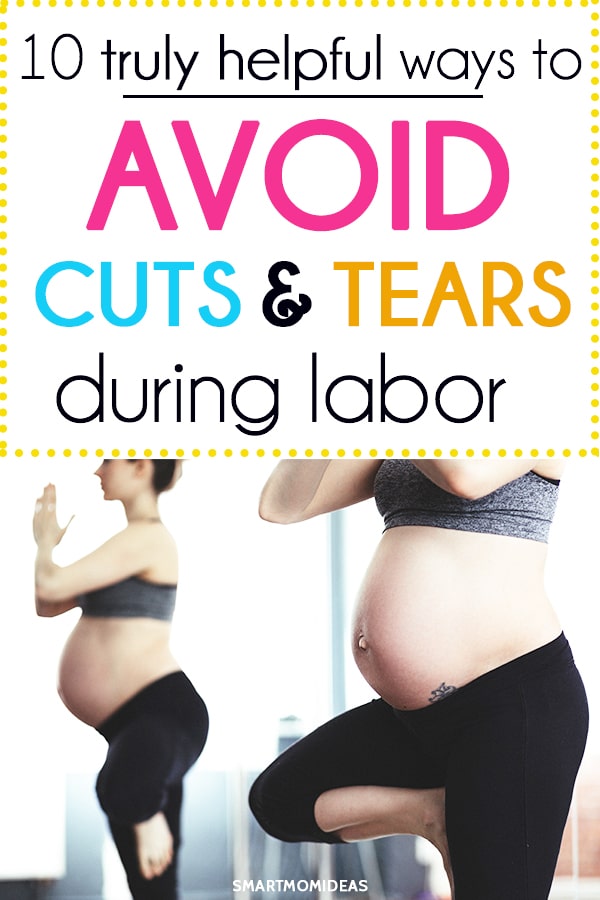Have a pain free childbirth with these life-saving tips for a first time mom.
Maybe you’re pregnant with your first baby and dread the idea of tearing.

Maybe you’ve already experienced tearing in childbirth….and want to avoid tearing again!!
And tearing has to be one of the number one fears about giving birth, right, mama?
But, there are some practical things you can do that might reduce your risk of tearing during childbirth – or at least, reduce the severity of your tear. Phew!!
So here are 10 quick tips to help you prevent tearing during childbirth.
I am not a medical professional and this should NOT be taken as medical advice. Although lots of women have found these tips to relieve pain in childbirth, each birth is different and so they may not work for you. If in doubt, please seek appropriate medical advice.
Best Ways to Avoid Tearing During Childbirth
1. Use a Warm Compress During Birth
It doesn’t sound like much.
But applying warmth to your perineum when baby is crowning can help prevent the worst tearing – and give you some relief!
This is a really simple technique that only takes a couple of minutes to set up. Perfect for when you’re in labor and need something NOW!
Lindsey from Mother Rising Birth shows us how this can be done with a few cheap washcloths and a crockpot to keep the water warm. Isn’t that an awesome idea?
2. Have a Waterbirth
Of course, if you’re having a waterbirth, you’ll already be feeling the benefits of warm water.
And such a simple technique, has to be worth a try, right? Many hospitals allow waterbirths so do your researching before you go into labor.
Also speak to your husband and doctor or midwife about this so they are aware of your wishes before you go into labor.
If you find that a waterbirth isn’t your ideal birth plan, you can also just take a shower or bath in the beginning stages of labor.
3. Change Your Position
We’ve all seen labor and childbirth scenes on TV, right? And the mama is usually shown lying flat on her back.
But this isn’t the easiest position to give birth in, because lying flat on your back makes for a smaller opening for baby to get through AND stops gravity helping you.
So before baby comes, try out different positions with your birth partner so you know what your options are. Here’s a great list of birthing positions.
Any upright and open position may help you avoid tearing. And helping you to try out different positions, is a great way for your husband or birth partner to support you during childbirth.
Changing your position during childbirth can also help you manage pain. Double win!
If you’re looking for other ways to cope with the pain of labor, check out this list of 10 life-saving tips for when you’re in labor.
4. Perineal Massage to Prevent Tearing
When I was pregnant and I first heard about this one, it was a straight-up ‘No’ from me!
But if you’re up for it, perineal massage might help prevent tearing during childbirth. But, what is it?
Perineal massage is basically massaging the area between your vagina and bottom in your last trimester to prepare for the stretch of childbirth.
Does it work?
There is conflicting evidence. But some studies do suggest that perineal massage can help, especially for first time moms.
If you’re interested in giving it a try, Sarah over at My Natural Baby Birth has an awesome how to guide.
As usual, I definitely recommend talking to your doctor or midwife before starting and being very gentle with yourself.
Good luck, mama!
5. Use a Lubricant
In your third trimester of pregnancy, start using a lubricant like coconut to massage your perineum. You can massage the area where tearing is prone and around in addition to perineal massage. This will help prepare the childbirth.
6. Try Swimming & Eat a Healthy Diet
Giving birth is exhausting!
So make sure you’re ready for labor by doing some gentle exercise – always speak to the appropriate medical professional before undertaking any exercise program.
And I’m not talking about running a marathon, mama!
Gentle exercise like walking or swimming can help your body prepare for labor. And as exercise improves circulation and skin elasticity, this is a simple and easy way to help prevent tearing during childbirth.
And having a good diet can explain that many mamas can have a reduced chance of tearing!
If you’re looking for nutritious, easy to prepare meals, take a look at this list of 25 vegan Instant Pot meals. And these will be lifesavers in that first busy postpartum week.
7. Do Kegel Exercises & Pelvic Floor Exercises
One type of beneficial exercise to open up your pelvic muscles is to do some kegals, or pelvic floor exercises. These types of exercises can also prevent pain in labor and any leakage that may happen!
Kegel exercises have you tighten and relax your vagina muscles. These are easy to do while you watch TV or even in the car!
8. Breathe Your Baby Out – Don’t Push
Did I mention that labor is exhausting already?
And just when you’re exhausted from coping with all those contractions, you have to make one last huge effort to push your baby out!!
But did you know you can ‘breathe’ your baby out? And this ‘breathing’ baby out can reduce tearing!
Yes, I know that sounds impossible. But check out this awesome video about J-breathing.
And making a conscious effort to think about your breathing can help you relax in labor and delivery – and that’s going to help baby get out as gently as possible. Double win!!
If you want to know more about birthing naturally, Ina May Gaskin’s books is full of helpful advice.
Ina May’s Guide to Childbirth

9. Listen to Your Body
Mama, this is a BIG one.
And to prove it, Mallaury from Life of Babe rounded up 9 mothers and asked them to share their best tips to avoid tearing in childbirth.
And one thing they all agree on is listen to your body.
This means doing things like moving into whatever position feels right, and pushing when you feel ready.
I know this sounds like a woo-woo kinda tip. But seriously, your body knows how to birth your baby!
If you’re doubting yourself, why not check out Childbirth Without Fear. It’s empowering, reassuring and full of practical information.
Childbirth Without Fear

10. Talk to Your Husband
Even the best laid birth plans have to change when the hard work of labor starts!
But it’s still vital that you write a birth plan and share it with your husband and your doctor or midwife. Your husband will be your champion in the delivery room when you’re not able to explain your wishes. He can support and coach you when you’re too busy dealing with contractions to think about changing positions!!
And the moment your baby is born, all that pain will disappear when you look into your baby’s eyes! It’s so worth it mama!
Looking for the perfect outfit for bringing baby home in? Check out these cute newborn outfits – which one will you choose?
What Happens When You Do Tear During Childbirth?
You can’t avoid tearing 100%.
Sometimes it will happen and sometimes the doctor will cut – called an episiotomy – to make childbirth possible. Their are different degrees of tears and if you do end up tearing, you will need a postpartum recovery plan based on what tear you received.
You can have a:
- 1st degree tear – this is the mildest tear and does not require stitches. For many women, it just feels like a stinging pain during childbirth (or when peeing).
- 2nd degree tear – this type of tear may require stitches and it does break skin. Muscles are involved as it’s a deeper tear.
- 3rd degree tear – this type of tear requires stitches. There is tearing in the vaginal tissues, perineal muscles and up to the muscles around your anus. This requires more patient care, antibiotics and more intervention from the doctors.
- 4th degree tear – this is a rare tear and does require stitches. This type of tear goes to your rectum and requires medical intervention and antibiotics.
Sometimes the doctor will cut you as a way to avoid tearing during childbirth. Why? An episiotomy is used to avoid a deeper tear, to deliver a stressed baby quickly or to make room for the baby to birth.
If possible, try to avoid an episiotomy as you’ll have a better postpartum recovery than if you naturally tore.
How Long Does it Take for a Perineal Tear to Heal?
If you ended up having an episiotomy or a second or third degree tear, it will generally take 2-3 weeks to heal. The stitches you get will naturally dissolve during this time. You may start to feel less pain after a week, but some woman take a month to fully recover.
Pro tip: Taking a sitz bath and relieve pain much quicker and speed up recovery!
How to Avoid Tearing During Childbirth
That’s it, mama! Seven tips to help avoid tearing during childbirth.
Just remember that every woman and baby are unique – so there’s no guaranteed way to avoid tearing during childbirth. All births are different and what works for one mama won’t work for another.
Don’t forget to pin for later!
Now you can get on with making those last few preparations for baby’s arrival, getting ready to take your baby home, and mastering breastfeeding.
Over to you – are you preparing to give birth? Are you worried about tearing? Do you have any vagina-saving tips to share? Tell me in the comments!!





Leave a Reply